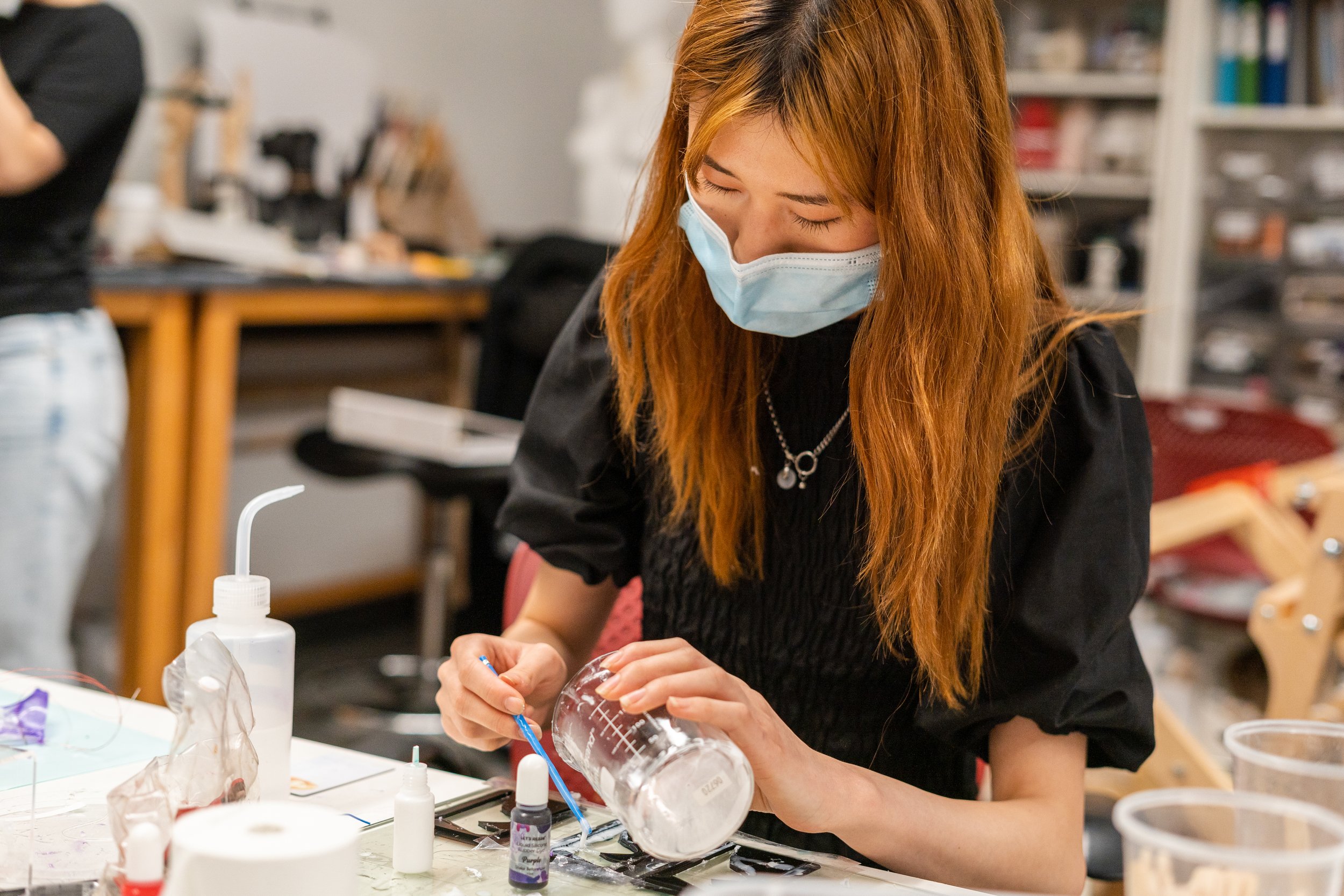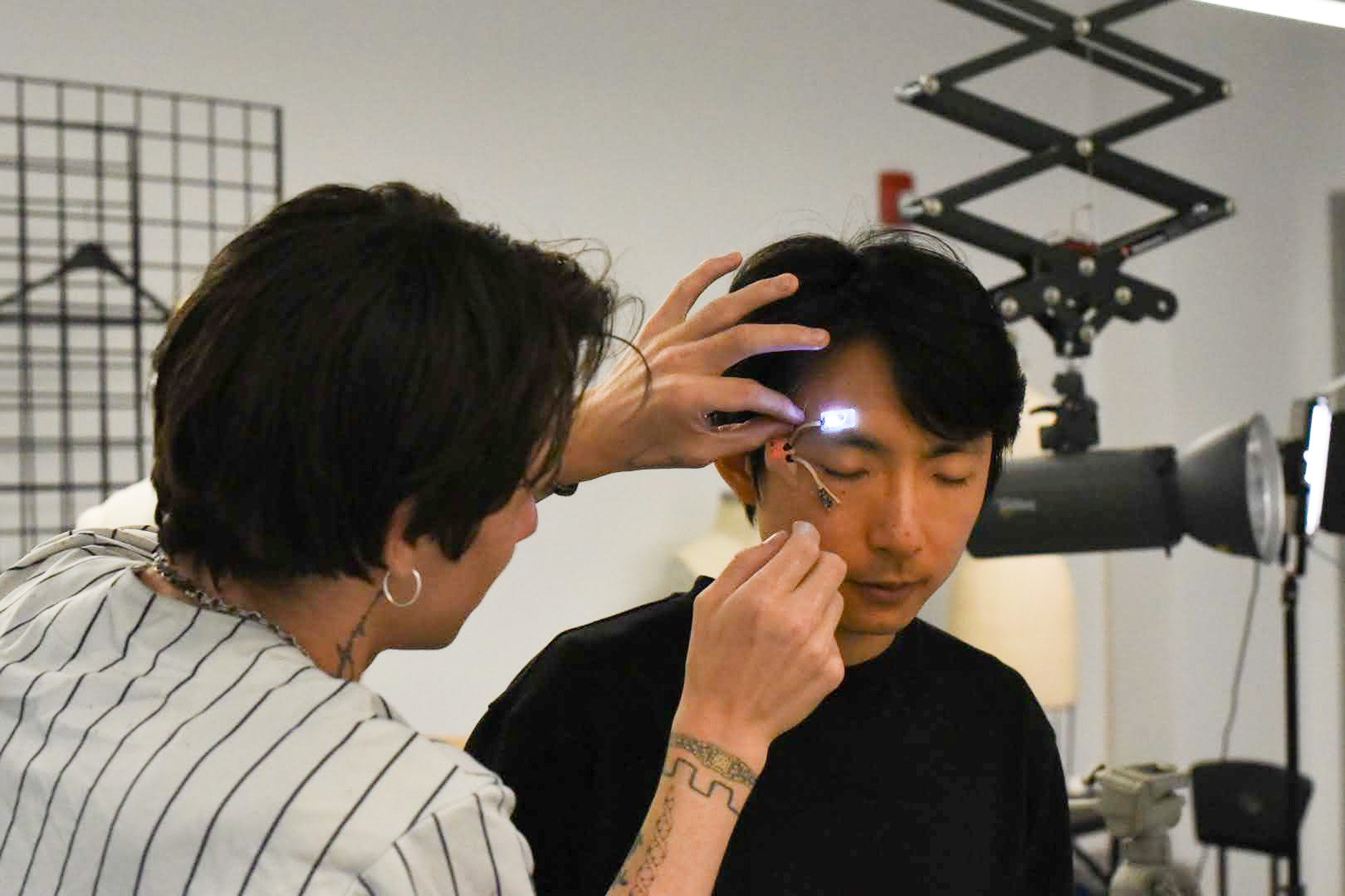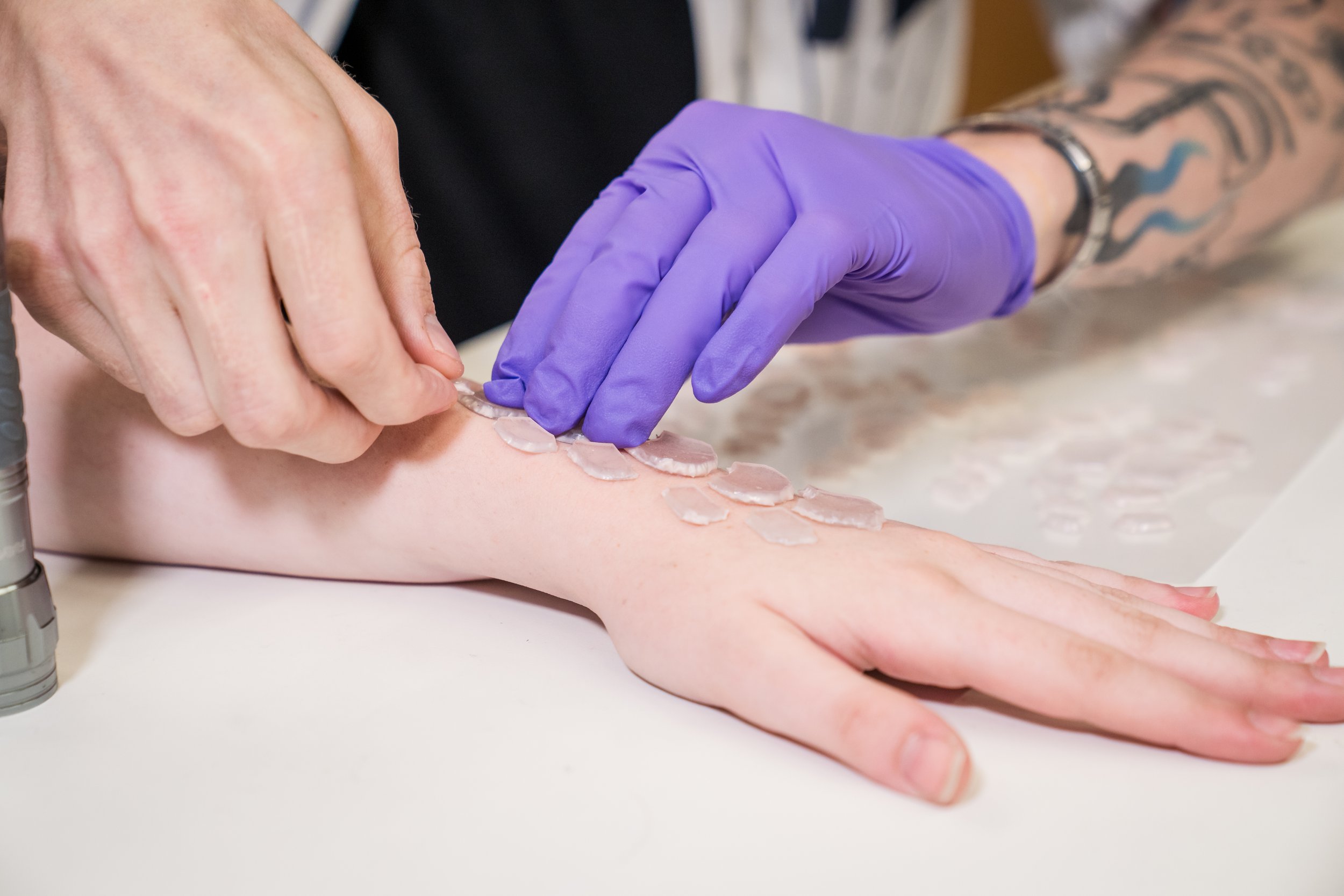Hybrid body lab ARTIST-IN-residence program
Hybrid Body Lab proudly presents a 2-month residency in the spring of 2026 for artists to collaborate with researchers to combine on-body design with emerging miniaturized technology. We are inviting artists who use skin and their appendages as a medium from any of the on-body art disciplines, including but not limited to nail art, hair art, (temporary) tattoo art, makeup, on-skin fashion, and body art. Artistic practices that sit in between mediums and categories are especially encouraged.
During the 2-month residency, the resident will be invited to get in touch with the latest interactive on-body technologies the lab is exploring, as well as collaborate with lab researchers to conceptualize and develop projects to explore possibilities of technology-involved art practices.
2026 RESIDENCY Information Session
2026 RESIDENCY DETAILS
WHEN
The residency will occur for 2 months between March 2nd, 2026, and May 1st, 2026 (9 weeks).
INFORMATION SESSION
We will host an information session on Thursday, July 31st, 2025, at 5 pm EST to share more details about the residency and answer questions. Recording Available Here
SUBMISSION DEADLINE
The application is due Thursday, September 18th, 2025, at 11:59 pm EST.
The recipient will be notified by October 24th, 2025.
Please note that this year’s residency (2026) is limited to US-based artists.
RESIDENCY SUPPORT
Selected residents will receive the following:
A $6120 stipend for the 2-month (9-week) duration, for a full time (40 hour per week) residency.
A material budget of $300 will be spent during the residency (this will not go directly to the artist but instead will be deducted from the Hybrid Body Lab budget).
Appropriate transportation reimbursement for artists (Max $300).
Access to the lab and equipment, including 3D printers, floor looms, sewing machines, knitting machines, wet lab, and electrical engineering workbench.
Access to techniques and practices shared by researchers who function as collaborators.
EXPECTATIONS OF THE ARTIST
The selected artist will be expected to
Collaborate with researchers to produce a body of work that integrates their art practice with emerging technology.
Be available to work with researchers in person in Ithaca, NY, for the duration of the residency. This is an in-person residency. The artist will be responsible for locating housing and travel to and from Ithaca, NY, if they are not local residents. Appropriate transportation reimbursement for artists (Max $300).
This is a full time residency. Spend 40 hours per week working in the lab and actively engaging with project collaborators and program organizers. 75% of your effort will be on your artist residency project, and 25% will be spent on contributing to collaborative research in the lab.
Deliver two artist talks: One at the start of the residency sharing their art practice, and one presenting their residency project towards the end of the program.
Provide detailed documentation of your daily progress and also the final outcome of the project.
Techniques developed during the residency will be open-sourced and shared with the collaborators and the public. This includes providing documentation for others to replicate their approach.
Participate in an exhibition on the Cornell campus showcasing the residency project. The exhibition will occur at the end of the residency in the spring of 2026.
Participate in interviews and reflection sessions to help researchers document and characterize the nature of the collaborative process.
Participate in research activities related to the residency project, including co-authoring research papers for publication.
The residency is a structured 2-month program with the following weekly schedules:
Week 1: Mutual exchange of practices and techniques between the artist and members of the Hybrid Body Lab. 5 labs will be presented to the resident, and hands-on workshops will be conducted.
Week 2: Brainstorm suitable topics for co-development throughout the AiR. The artist will partner in-depth with a researcher from the lab, who will serve as their primary project collaborator.
Week 3 - week 8: Project co-development and sample creation.
Week 9: Project wrap-up, public presentation, and exhibition of work.
SELECTION CRITERIA
We are looking for artists at all career stages, working with on-body art or looking to explore new possibilities in this medium. Eligible applicants must be 21+ years old and willing to spend 2 months in the Ithaca, New York region.
Please note that this year’s residency (2026) is limited to US-based artists.
Artists will be selected according to the following criteria:
Portfolio
Residency proposal
Potential for mutually beneficial collaboration
FREQUENTLY ASKED QUESTIONS (FAQ)
Q1. Do artists need to have any experience in technology?
Answer: No, artists do not need to have any experience in technology. During your first week, you will practice labs from the Hybrid Body Lab tutorials that will help expand your base knowledge. You will also have the opportunity to collaborate with researchers from the lab to inform your work during the residency.
Q2. Is the residency in person?
Answer: Yes, it is a hands-on residency located at the Hybrid Body Lab at Cornell University in Ithaca, New York.
Q3. What are your selection criteria?
Answer: We are looking for artists at all career stages, working with on-body art or looking to explore new possibilities in this medium. Eligible applicants must be 21+ years old and willing to spend eight weeks in the Ithaca, New York region. Artists will be selected according to the following criteria: portfolio, residency proposal, and potential for mutually beneficial collaboration.
Q4. Can artists outside of New York State apply?
Answer: Yes. But please note that we will be able to provide a maximum of $300 for travel reimbursement. Please note that this residency (2026) is limited to US-based artists.
ORGANIZERS
Director, Hybrid Body Lab
Associate Professor of Human Centered Design, Cornell University
Ph.D. Candidate, Hybrid Body Lab
Human Centered Design, Cornell University
Eddie Zhu
Ph.D. Student, Hybrid Body Lab
Information Science, Cornell University
COLLABORATION TEAM
As a collaborator in the Hybrid Body Lab, you will be working across the disciplines of art, design, and engineering. You would share the lab space with students and faculty listed on the Team page on the Hybrid Body Lab Website. You are expected to work closely with the organizers Cindy Hsin-Liu Kao, Jingwen Zhu, and Eddie Zhu.
SELECTION COMMITTEE / BOARD OF ADVISORS
The selection committee and organizers will work together to determine the finalists. The organizers will ultimately select the chosen resident.
Jaleesa Reed, Ph.D.
Assistant Research Professor of Human Centered Design, Cornell University
Dr. Jaleesa Reed is an Assistant Research Professor in the Department of Human Centered Design. Her primary research interest is in millennial Black women’s beauty culture and beauty retail spaces. Her interdisciplinary research focuses on connecting human geography, feminist studies, and merchandising in the fashion, apparel, and textile industries.
Sarah Gotowka
Artist
Owner & Directer, Luna Fiber Studio
Sarah Gotowka is a practicing textile artist and instructor. She has been weaving since 2005 and has been growing natural dyes since 2010. She received her BFA in Fibers and Material Studies from The Cleveland Institute of Art in 2007, and her MFA in Fibers and Material Practices from Concordia University in Montreal in 2013. Since moving to the Ithaca area she has taught at SUNY Cortland, Cornell University, Ithaca College, The Johnson Museum of Art, Wells College, and New Roots Charter School.
Oksana Ani
Sr. Designer for Advanced Knit, Nike Inc.
Interdisciplinary Designer, Thinker, Explorer
Oksana Ani is an experienced Designer, Thinker, Explorer and visual communicator who excels in cross-functional collaborations. Oksana leads innovation platforms that focus on impactful and sustainable product that is empowered by storytelling. She holds a Master's degree focused in Fashion Design from Royal College of Art and Innovation from MIT Media Lab. She is currently a Sr. Designer for Advanced Knit at Nike Inc.
Writer and Makeup Artist
Assistant Designer, Digital Product Creation, Tapestry Inc.
Morgan Chen is a multimedia artist based in New York City. She began her creative practice as a film makeup artist, leading her to develop a curiosity around body-centered art. This focus deepened during her Hybrid Body Lab artist residency, where she combined makeup technique and electronic sensors to create Social Prothesis, a dynamic facial wearable. Currently, Morgan works in 3D design in fashion, while continuing to cultivate a personal practice in socially engaged art. She is an active member of Art Against Displacement, a NYC Chinatown-based coalition of artists and cultural workers committed to fighting displacement locally and globally.
PREVIOUS RESIDENCY PROJECTS
2024 ARTIST-IN-RESIDENCE: VIVIANE LEE (Cyshimi) AND IKARO CAVALCANTE
Viviane Lee (Cyshimi) is a Brazilian artist in São Paulo, explores ancestry, identity, and beauty through nail art, challenging norms with "Performative Sculptures." Their work symbolizes resistance and empowerment, weaving narratives through shapes, colors and textures.
Ikaro Cavalcante is a Brazilian non-binary artist, explores identity, spirituality, nature, and technology through tattoo art, graphic design, and 3D work. Their art invites us into a liberated universe of personal subjectivities.
2023 ARTIST-IN-RESIDENCE: JOE GEORGE
Joe George is a multidisciplinary artist based in Brooklyn, NY, working in printing, 3D modeling, and tattooing, among other mediums. During his 8-week residency at our lab, Joe has delved into the world of three-dimensional on-skin objects, exploring diverse materials, prototyping with electronic components, and crafting unique on-body interactions.
2022 ARTIST-IN-RESIDENCE: Morgan Chen
As Hybrid Body Lab's inaugural artist-in-residence, Morgan Chen, explored the intersection between makeup, prosthetics, and miniaturized technology to create her concluding piece "Social Prosthesis," a moving appendage designed as two headpieces made from rigid and soft structures. This work has received the 2023 ISWC Design Exhibition Award.
ACKNOWLEDGEMENTS
This residency is funded by the National Science Foundation and a Cornell University College of Human Ecology Engaged Research Grant.
We are grateful to Laura Devendorf, Leah Buechley, and Jennifer Jacobs for their earlier work in Experimental Weaving and Clay Residencies which inspired this endeavor!








